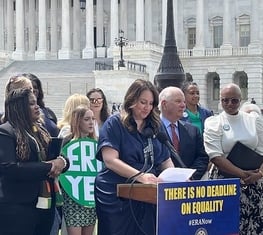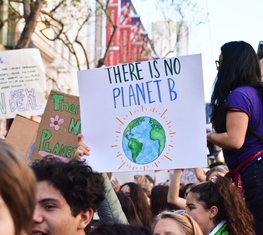Navigating In-Person Voting for 2020 Election
By now, you’ve probably heard a lot about the importance of having a plan for voting in the 2020 Election. Many civil rights organizations, and Leagues across the country, have fought to expand the availability of mail-in voting this election cycle, since the COVID-19 pandemic has made it necessary for more people than ever before to be able to vote from home.
But while this election will likely see the highest use of mail-in ballots in American history, in-person voting is still an option, and might be right for you!
Here’s what to know about in-person voting:
The vast majority of states have provided for early voting, which in most states, will begin several weeks before Election Day on November 3rd. “Early voting” allows a registered voter to cast their ballot in person (or in the case of states with all-mail elections, by mail) in advance of Election Day.
Early voting isn’t new—in fact, in Arizona, Florida, Montana, North Carolina, Nevada, Oregon, and Texas, the majority of the votes in the 2016 election were cast through early voting! But the reason early voting is becoming especially popular in the 2020 general election is because of its ability to minimize the risk of COVID-19 exposure for in-person voters by spreading out the number of voters over time and de-densifying polling locations on Election Day.
Twenty states and the District of Columbia provide for early voting on Saturdays in addition to weekday options, and several states also allow voters to cast their ballots on Sundays. If your work schedule poses a challenge on Election Day and you’re committed to voting in person, early voting might be a good option for you.
There are only six states that don’t offer any form of pre-Election Day voting (Missouri, Kentucky, Mississippi, South Carolina, Connecticut, and New Hampshire). To find out about your state’s in-person early voting options, check out this frequently updated list from the National Conference of State Legislatures, or contact your local election officials.
Curbside VotingIn addition to early in-person voting, curbside voting may be another way to minimize the risk of in-person voting for those who prefer to cast their ballot at their polling place. Many states previously offered a curbside voting program for individuals unable to enter a polling location because of age or disability. And some states, such as Iowa, Utah, and North Carolina, expanded their curbside voting program as a result of the pandemic, to include other vulnerable voters who are at higher risk of contracting COVID-19. Curbside voting will also be an option in some states, such as Texas, for people who have COVID-19 symptoms.
How Does Curbside Voting Work?
Typically, when an individual opts to use curbside voting, teams of election officials (one from each party) will bring a ballot or ballot-marking device to the voter’s car, and the voter is able to complete the ballot and submit it without having to leave the car. You can check with your local election office to find out the eligibility requirements and procedures for curbside voting in your area.
What Are States Doing to Prepare for In-Person Voting during the COVID-19 Pandemic?Since the COVID-19 pandemic began, states have been taking various steps to make sure Americans are able to exercise their right to vote as safely as possible. State and local election officials have had the opportunity to practice and hone their sanitation and social distancing procedures during the primary elections over the spring and summer so that they can troubleshoot any issues and be better prepared for Election Day on November 3.
Infrastructure
The CDC has required, at a minimum, that states maintain the same number of polling places used in the last presidential election, and has recommended that states work to increase the number of polling places to facilitate social distancing and de-densify voting locations.
In order to ensure that polling locations are adequately staffed, states began recruiting poll workers earlier than usual. And because the majority of poll workers in the 2018 election were over the age of 60—falling into a group that is generally at higher risk for developing COVID-19 symptoms and complications—states are taking additional steps to hire more poll workers from different age groups. For example, Milwaukee election officials have been actively recruiting high school and college students to staff polling places, and Vermont changed its procedures to allow poll workers to serve even if they are not local residents or are not yet 18 years old. Nongovernmental organizations have also been helping to encourage new poll worker sign-ups—over 10,000 people have volunteered to become poll workers after a recent recruitment campaign by More Than A Vote and the NAACP Legal Defense Fund.
Sanitation at the Polls
States have also taken a variety of steps to ramp up their sanitation procedures in response to the pandemic. Polling places will be cleaned more thoroughly and frequently than in prior elections. In addition, some polling locations will use Plexiglas partitions to protect poll workers, who will also be wearing full personal protective equipment (PPE), with masks, gloves, and face shields.
To minimize contact between voters and to increase sanitation, most poll locations will be offering hand sanitizer to voters entering the polling booth. Additionally, localities have piloted different practices to minimize the sharing of voting implements, like pens and touchscreens. In Maine, each voter will receive their own pen to take home as a souvenir, instead of the usual “I voted” sticker. Indiana and Louisiana will offer disposable finger coverings to allow voters to use touchscreens without risking the spread of the virus. South Carolina has also piloted using cotton swabs to minimize contact while voters cast their ballots via touchscreen machines.
Poll Location Policies
In addition to sanitation procedures, most polling locations will have special measures in place to encourage social distancing and limit contact between voters, including spaced out lines, voting booths that are at least six feet apart from one another, and capacity limits on the number of voters allowed inside at a given time. If you plan to vote in person on Election Day, you may need to allot more time than you typically do to cast your ballot. But don’t be too worried if the line at the polls looks longer than usual—it may appear that way because of social distancing but will move more quickly than you might expect. If you happen to have a lot of time to spare and the ability to drive to the polls, consider waiting in your car until the line is shorter so as to minimize your contact with others.
Although most states are not requiring voters to wear masks at the polls, the CDC recommends that voters wear a mask to protect others in case they are infected without symptoms. In most cases, people who attempt to enter polling locations without a mask will be offered one, and anyone who refuses to wear a mask will be escorted to a separate voting station away from others, where possible.
What You Can Do to Minimize Your Risk and Prevent the Spread of COVID-19 While Voting In-Person-
Wear a mask.
-
Stand six feet (or more!) away from others.
-
Participate in early voting, or go to the polls at off-peak times, as your schedule permits.
-
Have an alternate plan (such as curbside voting) in case you begin to experience COVID-19 symptoms on Election Day.
Remember that no matter how you choose to cast your ballot this year, you are entitled to do so without intimidation or interference! Make sure you know your rights before you head to the polls.
Sign Up For Email
Keep up with the League. Receive emails to your inbox!
Donate to support our work
to empower voters and defend democracy.





